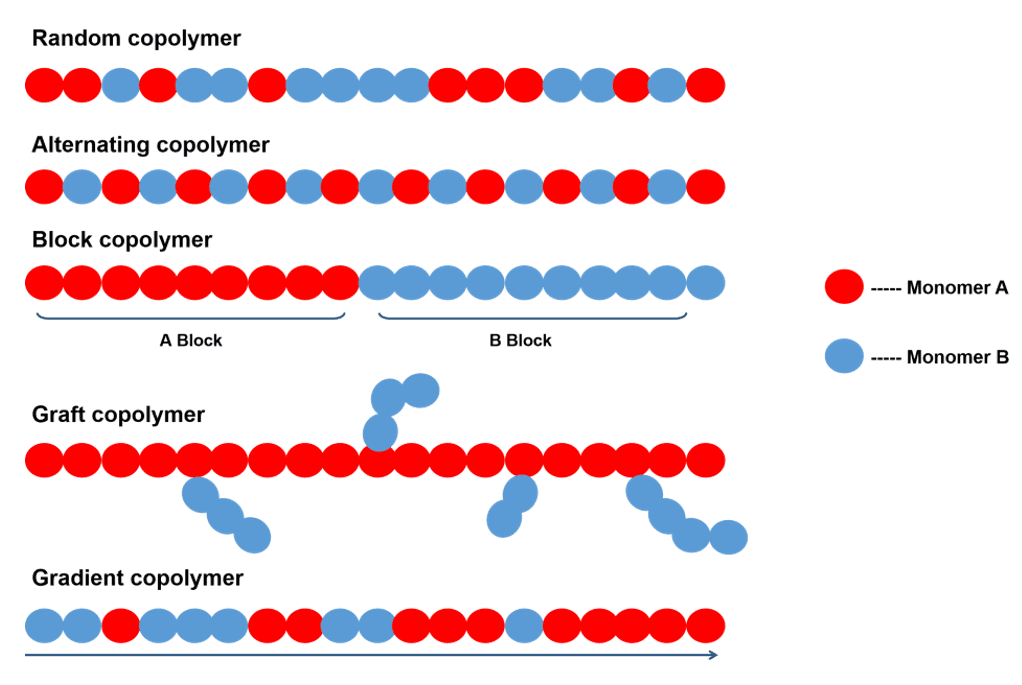- CAS: 113883-70-8
- Molecular Formula: CH3[C6H8O4]m[C4H6O3]nCH3
- CAS: 25036-13-9
- Molecular Weight: 216.20
- Molecular Formula: C5H12N8O2
- CAS: 25067-34-9
- Molecular Formula: (C2H4O.C2H4)x
- CAS: 25608-64-4
- Molecular Weight: 473.36
- Molecular Formula: C24H18Cl2O4S
- CAS: 25655-35-0
- Molecular Weight: 152.15
- Molecular Formula: C8H8O3
- CAS: 26658-88-8
- Molecular Weight: 80000
- CAS: 30965-26-5
- Molecular Weight: 266.29
- Molecular Formula: C14H18O5
- CAS: 31855-14-8
- Molecular Weight: 220.25
- Molecular Formula: N/A
- CAS: 83120-66-5
- Molecular Formula: (C5H10O3)x
Introduction

Copolymers refer to polymers formed by the polymerization of two or more monomers. The different monomers are linked by chemical bonds, unlike blends formed by mechanical or physical mixing. The composition and microscopic sequence structure of the copolymers are the keys to affect their properties. Our copolymer products include ethylene-maleic anhydride copolymers, vinyl chloride-vinyl acetate copolymers, poly(vinyl alcohol-co-ethylene) and many other types. Notably, our products not only have high chemical resistance, but also have excellent processability, rheology and physical properties.
Classification of Copolymers
According to the arrangement of the monomers in the copolymer molecular chain, generally speaking, the copolymers can be divided into four types: random copolymers, alternating copolymers, block copolymers and graft copolymers. In addition, there are structurally unique copolymer members such as gradient copolymers.

Synthesis of Copolymers
Copolymers can be synthesized by a variety of methods, and there are differences in the synthesis methods of copolymers of different structural types. Taking block copolymers as an example, block copolymers can be synthesized through the mutual reaction of functional end groups between different homopolymers, the control of monomer addition sequence in living polymerization, condensation reactions, and special initiators. Block polymers with specific structures will exhibit different properties than simple linear polymers and mixtures of many random copolymers and even homopolymers. They can be used as thermoplastic elastomers, blending compatibilizers, interface modifiers, etc., and are widely used in various fields such as biomedicine, construction, and chemical industry.
Research and Practice of Copolymers
The synthesis of copolymers greatly broadens the scope of polymer molecular design and is beneficial to improve the comprehensive properties of polymers. Some of the research developments in copolymers are described below.
The development direction of a new generation of polymer materials is to precisely control the monomer sequence of the polymer and the functionalization of the polymer side chain. Precisely functionalized polymer systems have unique spatial organization, folding and self-assembly properties, and have broad application prospects in many fields. For example, some scholars have successfully prepared AB alternating polyesters containing terminal alkenyl groups and internal alkenyl groups by ring-opening copolymerization (ROCOP) of epoxides with terminal alkenyl groups and cyclic anhydrides with internal alkenyl groups. The terminal alkenyl group and the end alkenyl group on the molecular chain structure can be modified by precise post-polymerization functionalization.
All-polymer solar cells are considered to be a new class of materials that can overcome the shortcomings of heterojunction polymer solar cells, and their research is very active. NDI-bithiophene-thiophene random copolymers based on NDI, bithiophene and single thiophene can be used as high-efficiency n-type polymer materials for the preparation of all-polymer solar cells.
If you are interested in our copolymer products, please contact us immediately!
References
- Ni Yi, et al. Orthogonal functionalization of alternating polyesters: selective patterning of (AB) n sequences. Chemical Science. 2019.
- Li Z, et al. High Performance All-Polymer Solar Cells by Synergistic Effects of Fine-Tuned Crystallinity and Solvent Annealing. Journal of the American Chemical Society. 2016, 138(34):10935.























